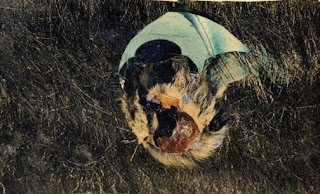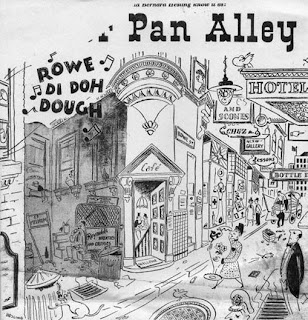Carl Plate (1909-1977) was one of Australia’s pioneering advocates for modernism. An influential artist and widely travelled art world figure, he lived and worked in the bush at Woronora River near Sydney, from 1945 until 1977. He advocated for modern art in post-war Sydney through his Notanda Gallery (1940-1974), active membership of the Contemporary Art Society and his own art practice. The vivid works in this collection reveal Plate’s ongoing commitment to collage, which ran parallel with his better-known painting.
Typical of his generation, Plate sought to study overseas, and travelled to Europe via Mexico, Cuba and the USA in 1935. He talked about having seen almost no images of modern art before leaving Australia, with the exception of an exhibition brought to Australia in 1933 by Clarice Zander (his future mother-in-law).1 ‘They were the first paintings that looked like something other than gum trees that I’d ever seen.’2
‘Adopted’ by the Australian Librarian at London’s Victoria and Albert Museum, Arthur Wheen (a relation of sculptor Gerald Lewers, Carl’s brother-in-law), Plate was introduced to artists and writers at the centre of change in Britain between the wars: Herbert Read, Henry Moore and T.S. Eliot. They were finding new forms to express a rapidly-changing world. A visit to the 1936 International Surrealist Exhibition in London completely altered Plate’s worldview. His pencilled notes and drawings in the catalogue refer to, among others, Hans Arp, Paul Klee, Joan Miro (he wrote ‘lots of fun’, and named his first daughter after him) and Dali’s Aphrodisiac Jacket (‘coat hung with over 100 glasses half filled with crème de menthe fly floating in each’). Plate also described Meret Oppenheim’s Plate, Cup and Spoon of fur.

Untitled [fur egg] c1975-6
magazine paper collage on transcryll and magazine paper
13 x 21
Plate returned from Europe at the fall of Paris in 1940, determined to set up his own modern art gallery, to enable people in Sydney to see what was happening in the world. He brought sixty-four works from thirty-two of the artists he’d met, including Moore, Barbara Hepworth, Ben Nicholson and Duncan Grant, exhibiting their work at his new Notanda Gallery in Rowe St, Sydney and then at Myers in Melbourne (where a young Sidney Nolan took money at the door and sold catalogues)3.
From 1940-42 he exhibited Desiderius Orban, Francis Lymburner, Contemporary Australian Drawings,4 Balinese Art, New French Painting,5 and held his own first solo show. By 1943 the Notanda Gallery concentrated on reproductions, books and journals. Running the gallery enabled Plate to promote the context for contemporary art and to keep up with new works of art and literature being produced here and overseas. With the arrival of more expatriates and refugees, Rowe Street became synonymous with all things cosmopolitan.

‘Pewter Pan Alley’ (Rowe St), Sydney Morning Herald, Bernard Hesling, 23/4/1946.
From 1940 Plate became an active member of the newly-formed Sydney Contemporary Art Society. ‘It was the evangelizing aspect that interested me. You’d “seen the light” and felt you should spread it.’ He felt ‘other people should share what you’ve discovered.’6 Busy re-establishing himself in Sydney, his own work as an artist emerged slowly. From early experiments with abstraction, he returned to semi-figurative work, experimenting with form, before moving into complete abstraction after 1958. Five years later, he was described as ‘one of Australia’s leading abstract painters.’7
We acknowledge the Darawal people as the original custodians of this land and their elders past and present and thank the Sutherland Shire Council for their ongoing support of Hazelhurst Regional Gallery & Arts Centre. Carl Plate: Collage would not have been possible without the support of Hazelhurst, whose Director Michael Rolfe responded to the idea of focusing on Plate’s collages with enthusiasm and dedication.
Without Rose Peel’s invaluable advice and work in rescuing many of the collages from their parlous state of disrepair, few would be available to us. Further thanks to Richard McMillan for generous cataloguing advice and to Ross Tzannes, who helps us sort out the management of an artist’s estate. A final thanks to our family, especially John Gillies for his unerring eye and support. We owe a special gratitude to A.D.S. Donaldson for his knowledge and advice about the conception and design of the exhibition and book, and for writing about Carl Plate’s collage practice. Donaldson’s essay re-reads Carl Plate’s modernism and places him in a new history of Australian collage, part of what he calls a history of UnAustralian art.
Daniel Thomas once wrote of Carl’s paintings: ‘each picture is a fresh exploration of form, not of a repetitious formula’;8 he could have been writing about the collages. We are honoured that he agreed to open the exhibition and write the preface. Few of Carl Plate’s collages, including his last set of unique ‘multi-strip’ works (1974-6), have been previously exhibited. This collection celebrates the long-term collage practice of a compelling and innovative artist.
Cassi Plate
Jocelyn Plate
1. Clarice Zander organised the ‘Exhibition of British Contemporary Art’ and accompanied it to Australia in 1932. Carl Plate remembers seeing Augustus
John, Epstein and Nash. ‘Enormous press coverage opened a debate – which became known as ‘the Zandrian War’ – as conservative audiences voiced
their displeasure,’ Christine France, Dictionary of Australian Artists Online, 2007.
2. Carl Plate, interview with Richard Haese, 29/6/74, State Library of Victoria.
3. The artists in the 1940 England Today exhibition are listed in the following essay, ‘Carl Plate, Within and Without’.
4. The artists exhibited were: Cardamatis, Dobell, Fizelle, Flower, Friend, Gleeson, Haxton, Hinder, Kingston, Lymburner, Medworth, Plate, Joshua Smith,
Strachan, Wienholt and Wilson.
5. ‘Modern French Painters’, 1941, exhibited gouaches, etchings and drawings by Bonnard, Braque, de Chirico, Derain, Dufy, Klee, Laurencin, Léger, Marquet,
Masson, Matisse, Miro, Modigliani, Pascin, Picasso, Roualt, Tanguey, Utrillo, Van Dongen and Vlaminck.
6. Carl Plate, interview with Richard Haese.
7. Sydney Morning Herald, 10/7/63
8. Daniel Thomas, ‘Three generations in one-man shows’, Sunday Telegraph, 17/11/63.
Taken from the catalog CARL PLATE, Collage, 1938-1976
No comments:
Post a Comment